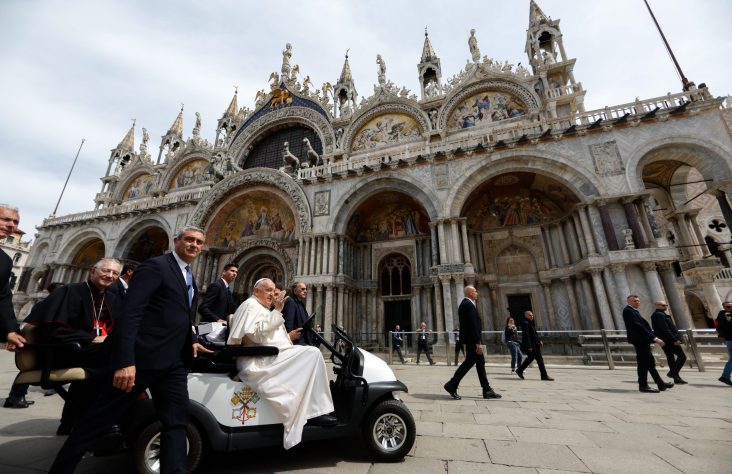February 21, 2024 // Perspective
Lenten Advice from Padre Pio: ‘Pray, Hope, and Don’t Worry’
During this Lenten season, many parishes offer the traditional devotion of the Stations of the Cross, which recalls the last hours of the passion of Jesus as he was condemned to death, carried His cross to Golgotha, was crucified, died, and was buried. This devotional practice has a long history. Twelfth-century chronicles written by Christian crusaders in Jerusalem mention praying along the “Sacred Way,” stopping for prayer at various points along the streets Jesus walked on His way to His death.
By the 15th century, the Franciscan friars who were (and remain today) the custodians of the Christian sites in the Holy Land were building outdoor shrine paths at churches across Europe that replicated the Way of the Cross for those who could not make a pilgrimage to Jerusalem. Today, most Catholic churches throughout the world feature artistic representations of the stations in sculpture or painting, spaced throughout the nave of the building so pilgrims can pray as they walk around the church. Some parishes have outdoor stations as well, and I’ve known a few laypeople who have the stations placed in their own gardens. Not too far west of our diocese, in St. John, Indiana, there is the Shrine of Christ’s Passion, which features full-size statues depicting the stations along a half-mile walking path.
The devotion itself typically features a procession with 14
individual stops, beginning with the condemnation of Christ and concluding with the burial of His body. In the most common version prayed in parishes, attributed to St. Alphonsus Liguori, each station begins with a versicle and response, then offers a brief reflection describing the action at the station, and concludes with a prayer of reparation in which each participant spiritually unites himself or himself to Jesus’ sacrifice.
In addition to Jesus, as we pray the stations, we encounter Mary, Mother of Our Lord, whose own heart was at that moment being pierced by a sword, as Simeon had prophesied. We encounter the veil-bearer, Veronica, offering her corporal work of mercy, and Simon of Cyrene, the unwilling cross bearer, and the women of Jerusalem, weeping in sorrow. Praying the stations immerses us in the historical, very real humanity of Jesus, fully on display as He fulfills the purpose for which He, in the fullness of time, emptied Himself of His Godhood, took flesh, and became obedient to death, even death on a cross (cf. Phil 2:5-8).
Earlier this month, I prayed the stations at a New York City church that is staffed by the Capuchin Franciscan friars. St. John the Baptist Parish, located near Penn Station, has a beautiful shrine devoted to St. Pius of Pietrelcina (more commonly known as “Padre Pio,” 1887–1968), who himself was a Capuchin friar. In his own time, he was a very well-known priest and confessor, famously gifted with the ability to read the souls of the faithful who came to him in confession so that he might assure his penitents of the great gift of God’s mercy. A young Father Karol Wojtyla, the future Pope St. John Paul II, traveled to visit Padre Pio in 1947; he later presided over the saint’s beatification and canonization.
Padre Pio was particularly renowned for bearing in his own body the stigmata – the wounds of Christ’s passion. Like his spiritual father St. Francis of Assisi, the first recorded saint to receive the stigmata, Padre Pio’s hands, feet, and side were marked with red spots that recalled the nails and lance with which Jesus was pierced. Though he was quite shy about it and covered his hands with gloves to hide the wounds, the sometimes painful marks in Padre Pio’s hands, feet, and side were external signs of his spiritual closeness to Christ.
The New York shrine, which features reliquaries containing a glove and a sock worn by Padre Pio to hide his stigmata, is located along the side of the church among the Stations of the Cross, placed immediately between the 11th (Jesus is nailed to the cross) and 12th (Jesus dies on the cross). As I was praying with the congregation, it struck me how beautifully appropriate this placement is. The wounds Padre Pio bore in his body are the same wounds Jesus, our Savior, bore in his body for the salvation of souls. The saint commemorated in this little church in the heart of Gotham is a modern-day public witness to the outpouring of mercy that flows from the side of the crucified Lord Jesus. In his priestly ministry, Padre Pio was a conduit of that same divine mercy, freely offered to the world most especially in the holy Eucharist and in the Sacrament of Confession.
One of Padre Pio’s most famous quotes is a fantastic piece of advice: “Pray, hope, and don’t worry. Worry is useless. God is merciful and will hear your prayer.” As we continue our Lenten journey, it is good to be reminded that the work of our salvation is already accomplished. Jesus, the Lamb of God, has taken away the sins of the world. The mercy that flowed from His pierced side is always on offer, we need only ask for it. Let us approach the throne of Jesus’ cross in devotion and trust, praying together, “We adore you, O Christ, and we praise you, because by your holy cross you have redeemed the world!”
Ken Hallenius is a syndicated radio host and podcaster living in South Bend.
The best news. Delivered to your inbox.
Subscribe to our mailing list today.






